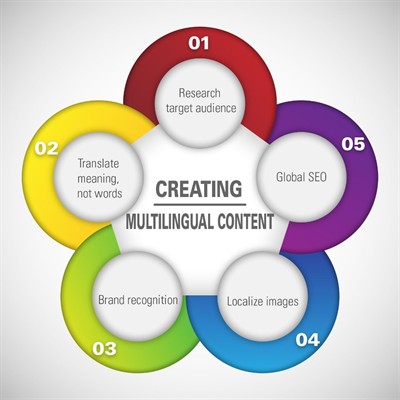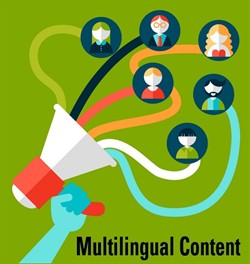Top Tips for Creating Multilingual Content

Content creation is a fundamental piece of all marketing strategies. Buyers want relevant information and they want it fast. Producing great content helps build relationships with your audiences, build brand loyalty and place your company in a position of trust and thought leadership.
But, is your content reaching all of your audiences?
Creating compelling content is essential, but so is taking the necessary steps to get that information to your target audiences. But, how do you make sure your content is compelling, informative and relevant to your target audiences? Creating multilingual content is more than just translating words.
Regardless if you are producing blogs, eBooks, whitepapers or website pages, you must communicate with your audience in a way that resonates with them.
In this blog, I have created a list of five top tips for creating multilingual content.

Research target audience
It is vital to have deep knowledge and understanding of your target audience’s cultures and languages. Decide which personas you are trying to attract and learn about their habits for communicating and for seeking information.
Some of the key questions to ask are:
- Are you targeting the language or the locale? Or both?
- What information are they searching for?
- What ways do they communicate?
- How do they access information? On mobile devices?
- What phrases and keywords do they use in internet searches?
- What is their culture like?
It is important to remember that language and culture are not the same. The United States and the United Kingdom both speak English, but our cultures are different and the phrases we use vary. For example, Americans say pants, and the British say trousers. This will reflect the keywords and phrases used in search queries, so be aware of the differences.
Also, language dialects differ from region to region. If your target audience is in Spain, don’t use Latin American Spanish for your content.
Translate meaning, not words
People communicate differently. We don’t just speak different languages, we express ourselves with different phrases, words and gestures. When localizing your content, the focus should be on the message not the words. Messages and meaning can literally get lost in translation.
After doing your target market research, have country and language experts advise you on how best to communicate your message in your content. Don’t rely on machine translation. Contact a translation agency with professional, human translators to get language and locale expertise and ensure your message in being expressed effectively.
Communicate with your audience in their language and focus on interpreting the message, not just translating the words.
Brand recognition
Your goal should be to have your brand recognizable regardless of what language your content is in. Keep a consistent tone and voice across your content. Adapt and localize your content for your audience, but don’t lose your brand’s distinguishing factors.
If you have a luxury brand, compete on quality, and your customers recognize your products or services by your extravagance and attention to detail, make sure that shines through in all your multilingual content. Keep to those standards as you translate and localize your content, so you are a distinguishable, global brand.

Localize images
Localization of images is something that can be easily forgotten in a content strategy if you focus only on text. But, being culturally sensitive and localizing your images for your audience can go a long way in user experience.
When you are marketing to other cultures, it is essential to understand their customs and beliefs to avoid offending anyone. Some colors, gestures and images can come across as innocent to one culture and extremely offensive to another.
Being up to date with the current events in your target audience is also important. If there is economic, environmental or political unrest you must be sensitive to these things in your content marketing efforts. Your audience will appreciate your dedication to understanding their country and culture and it will boost your brand reputation.
Global SEO
Once you have created great content and localized it for your audiences, your next step is to optimize it for search engine visibility. A global SEO strategy will help your content be found by your audiences. Localizing and optimizing your URLs, titles, Meta descriptions, alt tags, and keywords will help search engines index your content and deliver it to your audience appropriately.
These two blogs: Subdomains, Subdirectories or ccTLDs for Global Audiences and International SEO: On-Page Optimization offer additional information on the best strategies for optimizing your content for global audiences.
Summary
Producing great content is expected and appreciated by users. The digital age has allowed customers to have instant access to any information they need as they go through the stages of the buyers journey. Localizing and translating your content will help get your information to your target audiences. Offering multilingual content will make your global customers feel valued and respected.
Researching your audience, conveying your message, branding consistently, localizing your images and optimizing for search engines are all top tips to remember as you create multilingual content.
